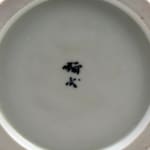Kusube Yaichi (1897–1984)
Saien Vase with Design of Persimmon
Signed “Yaichi” on foot
1954
With a box signed by the artist (1971)
W22.5 x H28.7 cm
Further images
Different from the conventional ceramic glazing method, Kusube Yaichi’s original saien technique involves the mixing of clay with color glazes and thin application of such a mixture called irotsuchi, or colored clay, one layer over another. By coloring clay, the saien technique brings the depths of colors out, and produces the color and form of a ceramic piece as a harmonious whole.
Most of Yaichi’s saien works are decorated with irotsuchi-applied motifs, whereas the present work is applied with irotsuchi all over, with its motif of Japanese persimmon represented by the methods of senbori, or outline-engraving, as well as nurinokoshi, or leaving unpainted. Other saien examples of such motif treatment by Yaichi are found in early 1950s, nearly a decade after his origination of the saien technique in 1937. Such treatment must be one of his early saien experiments.
The present vase represents the motif of persimmon in a simple and minimal design with a restrained palette. The black branch of the fruits adds to its modern and chic impression. Moreover, its refined cocoon shape as well demonstrates Yaichi’s mastery of the modern ceramic expression, which manifests the inherent aesthetic value of functionality.
Kusube Yaichi (ceramist; 1897–1984)
Kyoto-born ceramist. Apprenticed in the Kyoto tojiki shikenjo (Kyoto research institute for ceramics). Initiated the ceramists’ group Sekido-sha and became active in the field since then. Exhibited at Teiten, Nitten, among other exhibitions. Leader of Seito-kai. Consultant to Nitten. Member of the Japan Art Academy. Designated as a Person of Cultural Merit and received the Order of Culture.
Most of Yaichi’s saien works are decorated with irotsuchi-applied motifs, whereas the present work is applied with irotsuchi all over, with its motif of Japanese persimmon represented by the methods of senbori, or outline-engraving, as well as nurinokoshi, or leaving unpainted. Other saien examples of such motif treatment by Yaichi are found in early 1950s, nearly a decade after his origination of the saien technique in 1937. Such treatment must be one of his early saien experiments.
The present vase represents the motif of persimmon in a simple and minimal design with a restrained palette. The black branch of the fruits adds to its modern and chic impression. Moreover, its refined cocoon shape as well demonstrates Yaichi’s mastery of the modern ceramic expression, which manifests the inherent aesthetic value of functionality.
Kusube Yaichi (ceramist; 1897–1984)
Kyoto-born ceramist. Apprenticed in the Kyoto tojiki shikenjo (Kyoto research institute for ceramics). Initiated the ceramists’ group Sekido-sha and became active in the field since then. Exhibited at Teiten, Nitten, among other exhibitions. Leader of Seito-kai. Consultant to Nitten. Member of the Japan Art Academy. Designated as a Person of Cultural Merit and received the Order of Culture.







